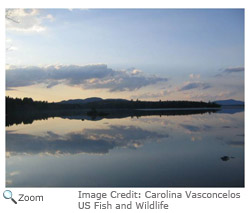Lake Layers
In some temperate regions, lakes often go through dramatic changes in temperature as the seasons change.
Summer Layers
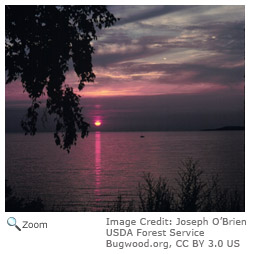
In the summer, the water temperature in lakes is not the same from top to bottom. There are three different layers. The top layer of water is heated by the sun and stays warm. The middle layer is cooler than the top layer and the bottom layer is the coldest. Because of the warmer waters and more plentiful food supply, almost all lake creatures spend the summer months in the upper layer.
Evening It Up

In the fall there is less sunlight to heat lake water during the day. Lakes can lose more heat at night and wind can mix up the water layers. When all of this happens, the water in lakes can become close to the same temperature at all levels. This is called
fall overturn.
Winter Flip
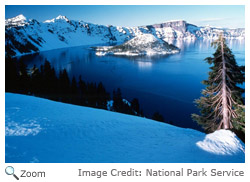
During cold winter months, lake temperatures can reverse! The top layer becomes coldest layer! When a lake's surface water reaches 32 degrees Fahrenheit (0 degrees Celsius), it begins to freeze. When the surface of the lake freezes, the water underneath is protected from wind and heat loss. In the winter, the deeper you go in a lake, the warmer the water will be!
Making Some Weather
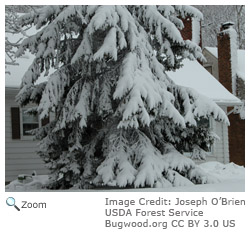
Some lakes are so large that they can create weather!
Lake effect snow happens when a cold air mass passes for long distances over warmer lake water. The air picks up moisture and heat from the lake. When the air mass reaches the lake shore, it often drops the moisture as snow. The Great Lakes generate lots of lake effect snow for surrounding areas.
Lakes By the Numbers
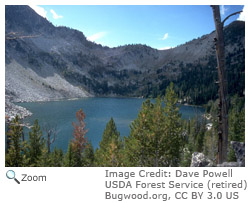
 There are about 30,000 cubic miles (48,270 cubic kilometers) of lake water in the world.
There are about 30,000 cubic miles (48,270 cubic kilometers) of lake water in the world.
 Lake water makes up about 0.4 percent of all the world's fresh water!
Lake water makes up about 0.4 percent of all the world's fresh water!
 About 80 percent of all the lake water in the world can be found in 40 large lakes and 70 percent of all the lake water in the world can be found in North America, Africa, and Asia.
About 80 percent of all the lake water in the world can be found in 40 large lakes and 70 percent of all the lake water in the world can be found in North America, Africa, and Asia.
 Close to half of all the world's lakes are in Canada!
Close to half of all the world's lakes are in Canada!
 The deepest freshwater lake in the world is Lake Baikal in Siberia. It is 5,371 feet deep!
The deepest freshwater lake in the world is Lake Baikal in Siberia. It is 5,371 feet deep!
 Lake Superior is the largest freshwater lake in the world. It has a surface area of 31,700 square miles and is over 380 miles long. At its widest part it is 160 miles across! Parts of Lake Superior are in Michigan, Minnesota, Wisconsin, and Ontario.
Lake Superior is the largest freshwater lake in the world. It has a surface area of 31,700 square miles and is over 380 miles long. At its widest part it is 160 miles across! Parts of Lake Superior are in Michigan, Minnesota, Wisconsin, and Ontario.
 New Hampshire has 1,300 lakes and ponds. The largest lake in New Hampshire is Lake
Winnipesaukee. It is
72 square miles and has over 253 islands in it. The distance around the lake is 184 miles!
New Hampshire has 1,300 lakes and ponds. The largest lake in New Hampshire is Lake
Winnipesaukee. It is
72 square miles and has over 253 islands in it. The distance around the lake is 184 miles!
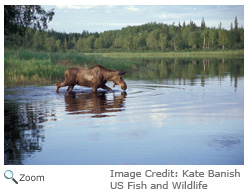 Lakes are not permanent. Over time all lakes will shrink and disappear. Some will dry out, others will fill up with sediment. This doesn't happen overnight. It can take thousands and thousands of years!
Lakes are not permanent. Over time all lakes will shrink and disappear. Some will dry out, others will fill up with sediment. This doesn't happen overnight. It can take thousands and thousands of years!
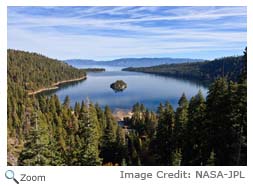 The Earth is constantly shifting and moving. Lots of the world's lakes formed because of changes in the land caused by earthquakes. Earthquakes sometimes leave basins in the Earth that become lakes. Many lakes in the western United States, like Lake Tahoe on the California-Nevada border, were formed in depressions formed by earthquakes.
The Earth is constantly shifting and moving. Lots of the world's lakes formed because of changes in the land caused by earthquakes. Earthquakes sometimes leave basins in the Earth that become lakes. Many lakes in the western United States, like Lake Tahoe on the California-Nevada border, were formed in depressions formed by earthquakes.
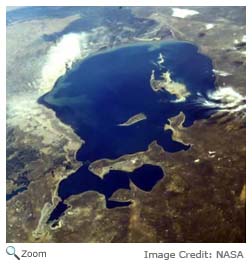 Other changes in the Earth happened more gradually. At one time the ocean covered parts of the Earth that are now dry land. The ocean floor lifted in some areas and dried out. Sometimes large bodies of water were cut off from the rest of the ocean. These areas became today's inland seas and lakes. The Caspian Sea and the Aral Sea were formed during this period when they were cut off from the ocean.
Other changes in the Earth happened more gradually. At one time the ocean covered parts of the Earth that are now dry land. The ocean floor lifted in some areas and dried out. Sometimes large bodies of water were cut off from the rest of the ocean. These areas became today's inland seas and lakes. The Caspian Sea and the Aral Sea were formed during this period when they were cut off from the ocean.
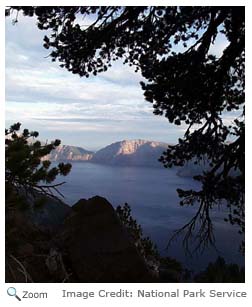 Some lakes form in the craters or calderas of extinct volcanoes. Crater Lake in Oregon lies in the caldera of an ancient volcano known as Mount Mazama! It is the deepest lake in the United States and the seventh deepest lake in the world. Other lakes have formed in craters left by meteorites!
Some lakes form in the craters or calderas of extinct volcanoes. Crater Lake in Oregon lies in the caldera of an ancient volcano known as Mount Mazama! It is the deepest lake in the United States and the seventh deepest lake in the world. Other lakes have formed in craters left by meteorites!
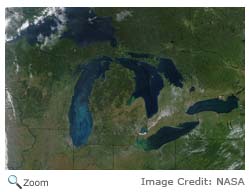 Glaciers are responsible for lots of the world's lakes. During the Pleistocene era (10,000 to one million years ago), the Earth went through four ice ages when glaciers or large sheets of ice and rock crept back and forth across the Earth's surface. As glaciers moved, they dug huge holes in the Earth. Eventually those holes filled with water and became lakes! The last ice age, the Wisconsinian, happened 10,000 to 125,000 years ago. Lakes created by glaciers in northern temperate regions formed during this last ice age. The Great Lakes and the Finger Lakes in North America were formed by glaciers during the Wisconsinian.
Glaciers are responsible for lots of the world's lakes. During the Pleistocene era (10,000 to one million years ago), the Earth went through four ice ages when glaciers or large sheets of ice and rock crept back and forth across the Earth's surface. As glaciers moved, they dug huge holes in the Earth. Eventually those holes filled with water and became lakes! The last ice age, the Wisconsinian, happened 10,000 to 125,000 years ago. Lakes created by glaciers in northern temperate regions formed during this last ice age. The Great Lakes and the Finger Lakes in North America were formed by glaciers during the Wisconsinian.
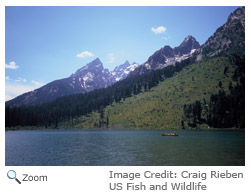 Lakes can be divided into three zones based on how much light penetrates the water. The littoral zone stretches across the lake surface and penetrates to where light can reach the lake bottom. The photic zone is the middle zone. Some sunlight reaches this zone and some plants grow here. The last zone is the aphotic zone. No sunlight reaches this zone, so there are no plants.
Lakes can be divided into three zones based on how much light penetrates the water. The littoral zone stretches across the lake surface and penetrates to where light can reach the lake bottom. The photic zone is the middle zone. Some sunlight reaches this zone and some plants grow here. The last zone is the aphotic zone. No sunlight reaches this zone, so there are no plants.  In the summer, the water temperature in lakes is not the same from top to bottom. There are three different layers. The top layer of water is heated by the sun and stays warm. The middle layer is cooler than the top layer and the bottom layer is the coldest. Because of the warmer waters and more plentiful food supply, almost all lake creatures spend the summer months in the upper layer.
In the summer, the water temperature in lakes is not the same from top to bottom. There are three different layers. The top layer of water is heated by the sun and stays warm. The middle layer is cooler than the top layer and the bottom layer is the coldest. Because of the warmer waters and more plentiful food supply, almost all lake creatures spend the summer months in the upper layer.
 In the fall there is less sunlight to heat lake water during the day. Lakes can lose more heat at night and wind can mix up the water layers. When all of this happens, the water in lakes can become close to the same temperature at all levels. This is called fall overturn.
In the fall there is less sunlight to heat lake water during the day. Lakes can lose more heat at night and wind can mix up the water layers. When all of this happens, the water in lakes can become close to the same temperature at all levels. This is called fall overturn.
 During cold winter months, lake temperatures can reverse! The top layer becomes coldest layer! When a lake's surface water reaches 32 degrees Fahrenheit (0 degrees Celsius), it begins to freeze. When the surface of the lake freezes, the water underneath is protected from wind and heat loss. In the winter, the deeper you go in a lake, the warmer the water will be!
During cold winter months, lake temperatures can reverse! The top layer becomes coldest layer! When a lake's surface water reaches 32 degrees Fahrenheit (0 degrees Celsius), it begins to freeze. When the surface of the lake freezes, the water underneath is protected from wind and heat loss. In the winter, the deeper you go in a lake, the warmer the water will be!
 Some lakes are so large that they can create weather! Lake effect snow happens when a cold air mass passes for long distances over warmer lake water. The air picks up moisture and heat from the lake. When the air mass reaches the lake shore, it often drops the moisture as snow. The Great Lakes generate lots of lake effect snow for surrounding areas.
Some lakes are so large that they can create weather! Lake effect snow happens when a cold air mass passes for long distances over warmer lake water. The air picks up moisture and heat from the lake. When the air mass reaches the lake shore, it often drops the moisture as snow. The Great Lakes generate lots of lake effect snow for surrounding areas.


